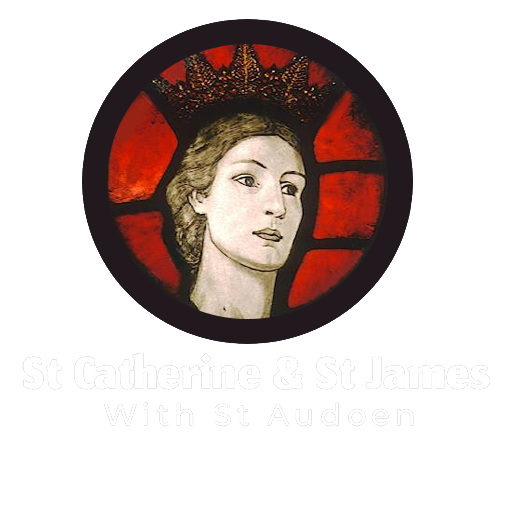Sunday Services
10.00 Eucharist, St Audoen Cornmarket (parking in Francis Street).
11.30 Eucharist, St Catherine & St James Donore Avenue (service of the Word Second and Fourth Sundays) and Sunday School. Family Service 3 April, Mothering Sunday.
Family Service at St Catherine’s and St James
Sunday 13 February was a notable day for the Parish. The children sang the songs which the Sunday School teachers had taught them, led by Karen Jordan, accompanied by Des Cox. The children read the story of the Good Samaritan and enacted it in a simple drama. The story of St Valentine was read, and the children led the prayers. Bernard Woods, Lay reader, presented a very effective children’s address. It’s still a mystery where the sound of birdsong came from. Tea and birthday cake were provided for the large attendance after service in the Transept which serves as a hall. Grateful thanks to all, in the background or in the limelight, who made this such an uplifting event.
St Catherine’s NS
Funds were supplied to the School for the purchase of musical instruments in memory of the late Ronnie Marino, organist and music teacher, after whom the School Hall is named. It was a delight to sit in the Hall recently and hear a long line of children play recorders, accompanied by the music teachers with piano and percussion, and another line of children play simple tunes on sweet violins. It’s no small task to get children to play together, no matter how simple the tune! There was more than one brave soloist, who with the rest earned sustained applause.
The Pram Shop at St Audoen’s
I was astonished to learn from my Mother that fifty years ago a pram and a push-chair were bought for the growing Gardner family at the pram shop in the High Street; even more surprised than I was when I learned that the shop is about to be knocked down. It has been a derelict eyesore between the two St Audoen’s Churches for decades, but has suddenly been the subject of a demolition order from Dublin City Council. However, it did have the advantage of framing one side of the plaza in front of the Polish St Audoen’s, which will be lost. Now, the old Church will be seen to collide with the more recent one, which towers over it. The gap between them is no more than a foot, and the floor of one is reached from the other by a long flight of steps. Perhaps a scheme of reinstatement of the streetscape, such as is recommended for the vicinity of St Werburgh’s Church nearby, would be better than such exposure, which, after all, was never before experienced by those visiting either Church, in their long, long history.
DCC
Dublin Council of Churches and the organisers of the St Patrick’s Day Festivities this year for the first time include an ecumenical service in the Festival programme. The Dean has kindly offered the use of St Patrick’s Cathedral at five o’clock. ‘ This event will bring alive the legacy of St. Patrick. We will hear his own words, Bible texts he loved, and haunting music and songs he has inspired. In doing so we encounter Patrick anew as an inspirational source of the faith we have in common; a faith that challenges, renews and sustains.’
The Church of South India
A service in the Malayalam language, according to the rite of the church of South India, was recently held in St Catherine and St James’ Church. The Revd Obinna Ulogwara (Chaplain for international community) and Philip McKinley (Ecumenical officer) were present, with the Revd William Deverall (Rector of Tallaght, where the Indian Orthodox Church meets), Canon Horace McKinley, the Vicar, and the Dean of Christ Church, who fulfils the duties of the Archbishop in this way, until Bishop Michael Jackson is installed.
Their secretary, John Kummankulathu Uthup, has furnished the following description: ‘The Church of South India (known as CSI) is the second largest Christian Community in India and is spread over four Southern Indian Provinces and in some parts of Northern Sri Lanka. CSI took its formal shape in 1947. CSI was formed by uniting various Western Protestant Missionary Churches in South India from the early 20 th century to function as a single Church for the growth of Christian mission within Southern India. The participant Churches were founded by the Protestant Missionary Organisations from Europe and England such as Church Missionary Society (CMS), Basal Mission, Methodist, Presbyterian churches and others.’
‘The Church of South India has 3.8 million members and 14000 congregations in 22 dioceses (including, for historical reasons, one diocese in northern Sri Lanka). The CSI runs 2000 schools, 130 colleges and 104 hospitals. In the 1960s, as part of its social responsibility, the Church started organizing rural development projects. There are 50 such projects all over India, 50 training centers for young people, and 500 residential hostels for a total of 35,000 children.’
‘In mid 2010 some of the Malayalam-speaking CSI members discussed their situation in Dublin and started to assemble in each others houses once a month as a prayer group, in their native language. The Revd Dr Jacob Thomas is currently working at the Belfast Bible College, an ordained minister of the Diocese of CSI Madhya Kerala in India, a resident priest in Northern Ireland, who is willing to help with the Malayalam Communion service to be conducted once in a month. So now they have decided to explore the possibility of building a partnership with Church of Ireland and thereby forming a CSI Malayalam Congregation, an ethnic congregation with the blessings and authorisation of the Archbishop of Dublin.’
Mark Gardner

